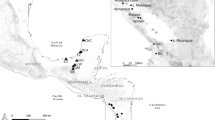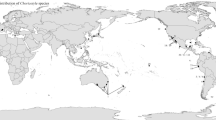Abstract
Procamallanus (Spirocamallanus) huacraensis infecting the catfish Trichomycterus spegazzinii from Escoipe River, Salta province (Argentina), is redescribed and genetically characterised for the first time, based on three genetic markers (nuclear 18S and 28S rRNA; cytochrome c oxidase subunit I [cox1] mtDNA). The phylogeny of Camallanidae was also discussed. Morphological evaluation of P. (S.) huacraensis using light and scanning electron microscopy revealed the previously undescribed features: location of deirids, accurate morphology of larvae (L1) and ovijector in females, as well as phasmids in males. Differences were found comparing the newly collected material and the type specimens, probably because the original description lacked detailing. Unfortunately, type specimens of P. (S.) huacraensis were no available for loan. The results of morphological and genetic analyses supported the validity of P. (S.) huacraensis. Inconsistencies regarding the taxonomic identification of species of Camallanidae in GenBank database were noted. Based on the current genetic database of Camallanidae, phylogenetic reconstructions using the 18S rRNA sequences were most consistent, due to the inclusion of higher number of taxa. Procamallanus (S.) huacraensis appeared as sister group of P. (S.) rarus, also isolated from a catfish in a neighbouring region. The order and habitat of hosts were also similar within some well-supported parasite lineages, but without common geographic origin. However, it is still premature to make definitive affirmations regarding the role of such features in the phylogenetic patterns of Camallanidae, given the scarcity of genetic data. The phylogenetic reconstructions also confirmed the artificiality of the morphology-based systematics of the family.



Similar content being viewed by others
References
Anderson RC, Chabaud AG, Willmott S (2009) Keys to the nematode parasites of vertebrates: archival volume. CABI Publishing, Wallingford
Černotíková E, Horák A, Moravec F (2011) Phylogenetic relationships of some spirurine nematodes (Nematoda: Chromadorea: Rhabditida: Spirurina) parasitic in fishes inferred from SSU rRNA gene sequences. Folia Parasitol 58:135–148. https://doi.org/10.14411/fp.2011.013
Chang J-M, Di Tommaso P, Notredame C (2014) TCS: a new multiple sequence alignment reliability measure to estimate alignment accuracy and improve phylogenetic tree reconstruction. Mol Biol Evol 31:1625–1637. https://doi.org/10.1093/molbev/msu117
Darriba D, Taboada GL, Doallo R, Posada D (2012) jModelTest 2: more models, new heuristics and parallel computing. Nat Methods 9:772. https://doi.org/10.1038/nmeth
Freitas JFT, Ibáñez HN (1968) Fauna helmintológica del Perú: nueva especie del género Spirocamallanus Olsen, 1952 (Nematoda, Camallanoidea). Bol Chil Parasitol 23:146–148
Froese R, Pauly D (Eds) (2019) FishBase. World Wide Web electronic publication. http://www.fishbase.org, version 02/2019. Accessed 22 Feb 2019
Gaither MR, Aeby G, Vignon M, Meguro Y, Rigby M, Runyon C, Toonen RJ, Wood CL, Bowen BW (2013) An invasive fish and the time-lagged spread of its parasite across the Hawaiian archipelago. PLoS One 8:e56940. https://doi.org/10.1371/journal.pone.0056940
Giese EG, Santos JN, Lanfredi RM (2009) A new species of Camallanidae from Ageneiosus ucayalensis (Pisces: Siluriformes) from Pará state, Brazil. J Parasitol 95:407–412. https://doi.org/10.1645/GE-1680.1
Guindon S, Gascuel O (2003) A simple, fast, and accurate algorithm to estimate large phylogenies by maximum likelihood. Syst Biol 52:696–704. https://doi.org/10.1080/10635150390235520
Huelsenbeck JP, Ronquist F (2001) MrBayes: Bayesian inference of phylogenetic trees. Bioinformatics 17:754–755. https://doi.org/10.1093/bioinformatics/17.8.754
Kuzmin Y, Tkach VV, Snyder SD, Bell JA (2011) Camallanus Railliet et Henry, 1915 (Nematoda, Camallanidae) from Australian freshwater turtles with descriptions of two new species and molecular differentiation of known. Acta Parasitol 56:213–226. https://doi.org/10.2478/s11686-011-0015-0
Moravec F (1998) Nematodes of freshwater fishes of the Neotropical region. Academia, Praha
Moravec F, Chara J, Shinn AP (2004) Two nematodes, Dentinema trichomycteri n. g., n. sp. (Cosmocercidae) and Procamallanus chimusensis Freitas & Ibáñez, 1968 (Camallanidae), from catfishes Trichomycterus spp. (Pisces) in Colombia. Syst Parasitol 59:189–197. https://doi.org/10.1023/B:SYPA.0000048098.80098.26
Moravec F, Justine J-L, Würtz J, Taraschewski H, Sasal P (2006) A new species of Procamallanus (Nematoda: Camallanidae) from Pacific eels (Anguilla spp.). J Parasitol 92:130–137. https://doi.org/10.1645/GE-3509.1
Moravec F, Justine J-L (2017) Two new species of nematode parasites, Cucullanus epinepheli sp. n. (Cucullanidae) and Procamallanus (Spirocamallanus) sinespinis sp. n. (Camallanidae), from marine serranid and haemulid fishes off New Caledonia. Folia Parasitol 64(011). https://doi.org/10.14411/fp.2017.011
Moravec F, Sey O (1988) Nematodes of freshwater fishes from North Vietnam. Part 1. Camallanoidea and Habronematoidea. Acta Soc Zool Bohemoslov 52:128–148
Moravec F, Thatcher VE (1997) Procamallanus (Denticamallanus subgen. n.) dentatus n. sp. (Nematoda: Camallanidae) from the characid fish, Bryconops alburnoides, in the Brazilian Amazon. Parasite 4:239–243
Moravec F, Van As LL (2015) Procamallanus (Spirocamallanus) spp. (Nematoda: Camallanidae) from fishes of the Okavango River, Botswana, including P. (S.) serranochromis n. sp. parasitic in Serranochromis spp. (Cichlidae). Syst Parasitol 90:151–164. https://doi.org/10.1007/s11230-014-9542-z
Notredame C, Higgins DG, Heringa J (2000) T-coffee: a novel method for fast and accurate multiple sequence alignment. J Mol Biol 302:205–217. https://doi.org/10.1006/jmbi.2000.4042
Ramallo G (2008) Nueva especie de Procamallanus (Spirocamallanus) (Nematoda, Camallanidae), parásito de Trichomycterus corduvensis (Siluriformes: Trichomycteridae), en el Norte de Argentina. Acta Zool Lilloana 52:25–29
Ramallo G, Padilla Bortayro G (2011) Nemátodos parásitos de peces dulceacuícolas de la Provincia de Catamarca, Argentina. Acta Zool Lilloana 55:261–263
Rigby MC, Adamson ML (1997) Spirocamallanus species of French Polynesian coral reef fishes. Can J Zool 75:1270–1279. https://doi.org/10.1139/z97-150
Sardella CJ, Pereira FB, Luque JL (2017) Redescription and first genetic characterisation of Procamallanus (Spirocamallanus) macaensis Vicente & Santos, 1972 (Nematoda: Camallanidae), including re-evaluation of the species of Procamallanus (Spirocamallanus) from marine fishes off Brazil. Syst Parasitol 94:657–668. https://doi.org/10.1007/s11230-017-9728-2
Tantaleán VM, Franco AH, Huayta EH (1985) Helmintos parásitos de peces de agua dulce del Perú. Instituto de Investigaciones para el Desarrollo Social del Altiplano, Puno
Wijová M, Moravec F, Horák A, Lukeš J (2006) Evolutionary relationships of Spirurina (Nematoda: Chromadorea: Rhabditida) with special emphasis on dracunculoid nematodes inferred from SSU rRNA gene sequences. Int J Parasitol 36:1067–1075. https://doi.org/10.1016/j.ijpara.2006.04.005
Wu SG, Wang GT, Xi BW, Gao D, Nie P (2008) Molecular characteristics of Camallanus spp. (Spirurida: Camallanidae) in fishes from China based on its rDNA sequences. J Parasitol 94:731–736. https://doi.org/10.1645/GE-1219.1
Wu SG, Wang GT, Xi BW, Xiong F, Liu T, Nie P (2009) Population genetic structure of the parasitic nematode Camallanus cotti inferred from DNA sequences of ITS1 rDNA and the mitochondrial COI gene. Vet Parasitol 164:248–256. https://doi.org/10.1016/j.vetpar.2009.04.030
Acknowledgements
The authors would like to thank Dr. Elias Nogueira de Aguiar from the Laboratório Multiusuário de Análises de Materiais do Instituto de Física (MULTILAM-INFI), from the Universidade Federal de Mato Grosso do Sul (UFMS), for the help with scanning electron microscopical procedures, and Dr. Carina Elisei from the Universidade Católica Dom Bosco, for providing the facilities for molecular studies. Thanks are also due to the Secretaría de Medio Ambiente del Gobierno de la Provincia de Salta for allowing us to make the collection of ichthyology, and Florencia Liquín, José Saravia, Roberto Sanchez, Federico Soria and Facundo Leguizamon for their assistance in the field work.
Funding
This work was financed in part by the Coordenação de Aperfeiçoamento de Pessoal de Nível Superior-Brasil (CAPES)-Finance code 001 and by the Consejo de Investigación de la Universidad Nacional de Salta (CIUNSa) (grant number 2193/3). F. B. P. was supported by a Post-doctoral fellowship PNPD-CAPES (Programa Nacional de Pós-Doutorado-Coordenação de Aperfeiçoamento de Pessoal de Nível Superior-CAPES, Brazil). L. A. C. was supported by a Doctoral fellowship from the Consejo Nacional de Investigaciones Científicas y Técnicas (CONICET, Argentina); L. E. R. T. was supported by a researcher’s fellowship from the Conselho Nacional de Desenvolvimento Científico e Tecnológico (CNPq, Brazil) (313292/2018-3).
Author information
Authors and Affiliations
Corresponding author
Ethics declarations
Conflict of interest
The authors declare that they have no conflict of interest.
Additional information
Section Editor: Guillermo Salgado-Maldonado
Publisher’s note
Springer Nature remains neutral with regard to jurisdictional claims in published maps and institutional affiliations.
Rights and permissions
About this article
Cite this article
Ailán-Choke, L.G., Davies, D.A., Tavares, L.E. et al. An integrative taxonomic assessment of Procamallanus (Spirocamallanus) huacraensis (Nematoda: Camallanidae), infecting the freshwater catfish Trichomycterus spegazzinii (Siluriformes: Trichomycteridae) in Argentina. Parasitol Res 118, 2819–2829 (2019). https://doi.org/10.1007/s00436-019-06429-0
Received:
Accepted:
Published:
Issue Date:
DOI: https://doi.org/10.1007/s00436-019-06429-0




